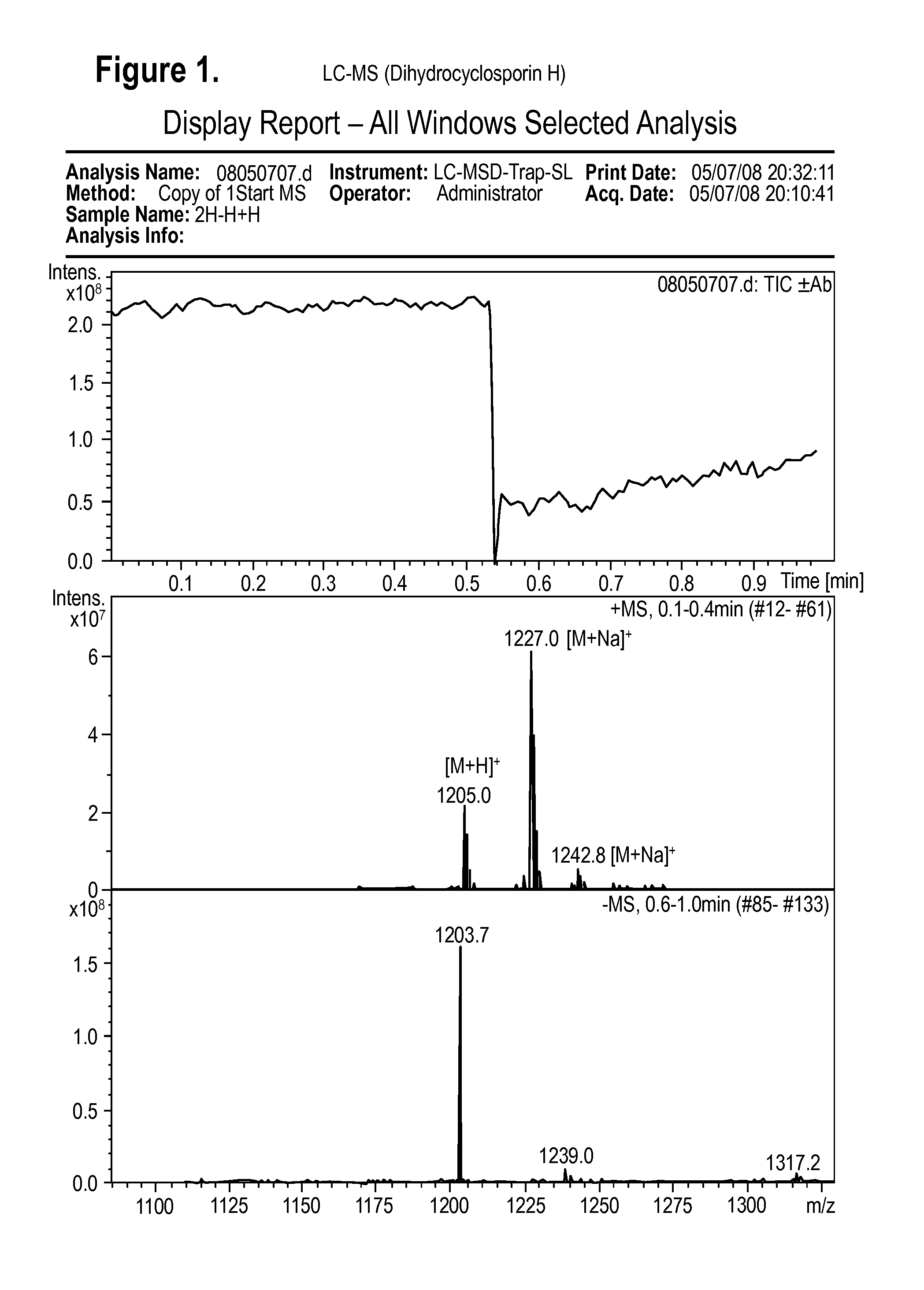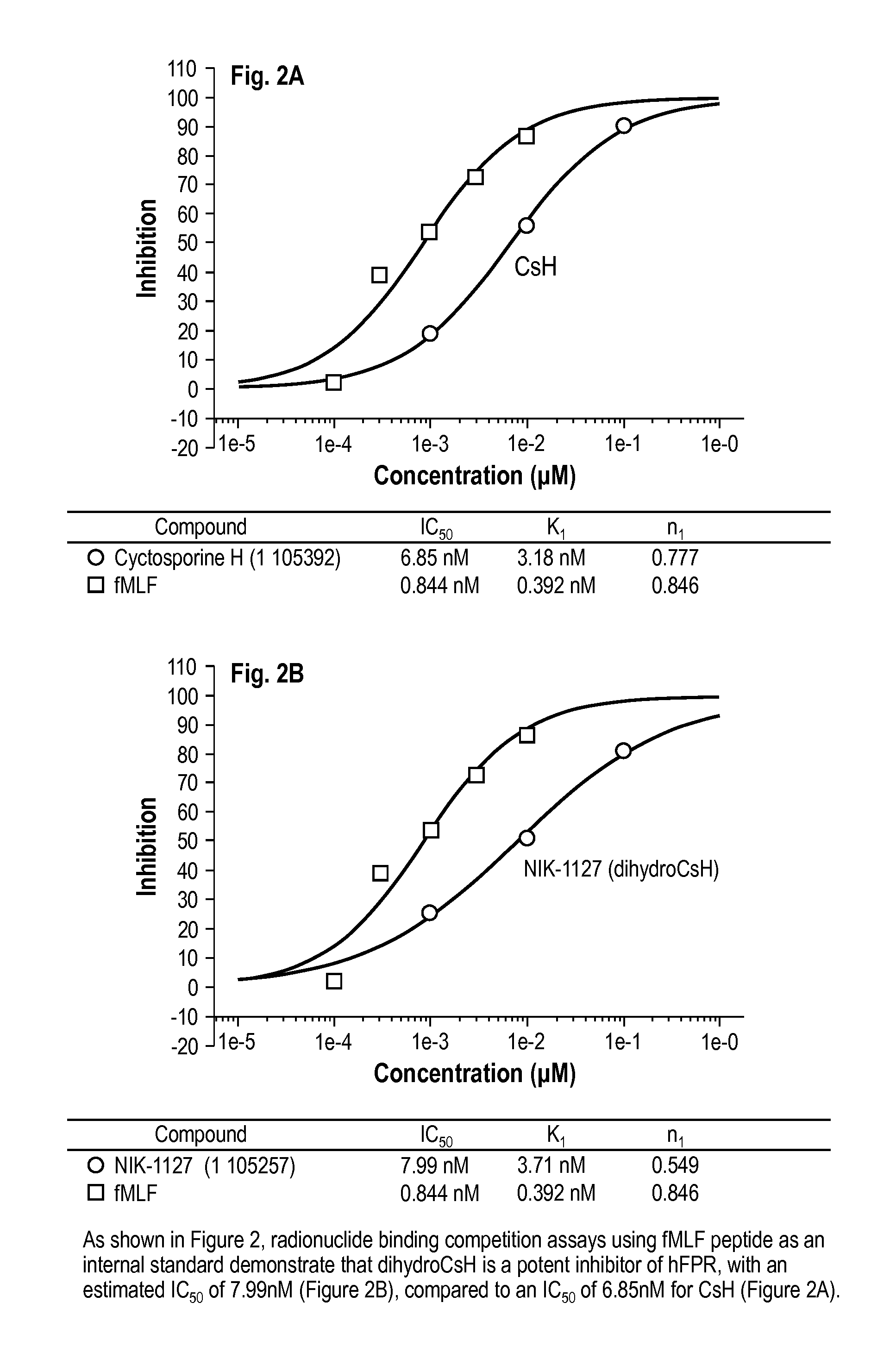Antagonism of human formyl peptide receptor for treatment of disease
a human formyl peptide and receptor technology, applied in the field of antagonism of human formyl peptide receptor for disease treatment, can solve the problems of affecting the responsiveness of the airway, unable to accurately capture all the physiological and pathological features of the disease, and significant and persistent decrease of circulating eosinophils, so as to improve the eosinophilic function, reduce the accumulation or activation of eosinophils, and reduce local eosinophil cell numbers
Inactive Publication Date: 2012-09-13
NIKAN PHARMA
View PDF3 Cites 0 Cited by
- Summary
- Abstract
- Description
- Claims
- Application Information
AI Technical Summary
Benefits of technology
[0019]In yet another aspect, provided herein is a method of decreasing eosinophil mobilization in a subject, comprising administering to said subject an effective amount of a formyl peptide receptor (FPR) antagonist, such that eosinophil mobilization in said subject is decreased. In one embodiment, the FPR antagonist is an immunobinder or a nucleic acid aptamer. In another embodiment, the immunobinder is an anti-FPR antibody.
[0027]In another aspect, provided herein is a method for decreasing the accumulation of eosinophils at sites associated with a disease related to increased eosinophilic function or decreasing localized eosinophil cell numbers in a subject, comprising administering to said subject a therapeutically effective amount of cyclosporine H or dihydro cyclosporine H, such that the accumulation of eosinophils at sites associated with a disease related to increased eosinophilic function or localized eosinophil cell numbers in said subject is decreased. The site can be, for example, the gastrointestinal tract, the lung or the skin. In one embodiment, the disease related to increased eosinophilic function or localized eosinophil cell numbers is selected from asthma, including, allergen associated, idiopathic, and atopic asthma or chronic obstructive pulmonary disease (COPD), including emphysema and chronic obstructive bronchitis. In another embodiment, the disease related to increased eosinophilic function or localized eosinophil cell numbers is selected from dermatitis, eczema, and psoriasis.
Problems solved by technology
Although a number of animal (e.g. mouse) models exist, none accurately capture all the physiological and pathological features of the disease.
In several such studies, administration of such antibodies has resulted in a significant and persistent decrease in circulating eosinophils.
Such remodeling is thought to chronically abrogate the responsiveness of the airway in asthma patients.
While these events represent important physiological components of innate immune response, several pathological conditions are associated with inappropriate or exaggerated activation of neutrophils and thereby cause excessive tissue damage.
Exaggerated or inappropriate neutrophil response may be detrimental and plays a key role in the etiology, pathophysiology, or symptomology of a number of medically important diseases and disorders, many of which have few if any desirable or effective treatment options.
In each case, however, a balance must exist that allows robust enough response to respond to infection, but not reaching a point of unnecessary or undesirable destruction or damage to host tissue.
Airway inflammation is a major factor in its pathogenesis, with tissue destruction of the lung the greatest cause of morbidity and mortality.
Antibiotic therapy typically has limited efficacy that diminishes over time.
Similarly, corticosteroid therapies have some utility, but side effects preclude their widespread or common use.
Method used
the structure of the environmentally friendly knitted fabric provided by the present invention; figure 2 Flow chart of the yarn wrapping machine for environmentally friendly knitted fabrics and storage devices; image 3 Is the parameter map of the yarn covering machine
View moreImage
Smart Image Click on the blue labels to locate them in the text.
Smart ImageViewing Examples
Examples
Experimental program
Comparison scheme
Effect test
synthesis examples
Prophetic Synthesis Examples
[0182]
the structure of the environmentally friendly knitted fabric provided by the present invention; figure 2 Flow chart of the yarn wrapping machine for environmentally friendly knitted fabrics and storage devices; image 3 Is the parameter map of the yarn covering machine
Login to View More PUM
| Property | Measurement | Unit |
|---|---|---|
| concentrations | aaaaa | aaaaa |
| energy uptake | aaaaa | aaaaa |
| structures | aaaaa | aaaaa |
Login to View More
Abstract
The present invention is directed to modulators of eosinophilic and neutrophilic function and the use of such modulators for treatment of eosinophil-associated and neutrophil-associated diseases.
Description
BACKGROUND OF INVENTION[0001]Eosinophils and neutrophils are blood cells that play an important role in the immune response. Eosinophils are immune cells that, in addition to their role in fighting parasitic infection, are associated with a variety of immune and allergic disorders. They develop in the bone marrow and are mobilized into the blood. Unstimulated circulating eosinophils persist in the bloodstream for 8-12 hours. Eosinophil differentiation is regulated by a number of factors, including IL-3, IL-5, and GM-CSF. In particular, animal models first suggested a predominant role of IL-5 in expansion and mobilization of eosinophils from bone marrow to the bloodstream and to the lung.[0002]Asthma is a highly prevalent allergic disorder of complex and poorly understood etiology. Although a number of animal (e.g. mouse) models exist, none accurately capture all the physiological and pathological features of the disease. Nonetheless, it is clear that eosinophils are among the implic...
Claims
the structure of the environmentally friendly knitted fabric provided by the present invention; figure 2 Flow chart of the yarn wrapping machine for environmentally friendly knitted fabrics and storage devices; image 3 Is the parameter map of the yarn covering machine
Login to View More Application Information
Patent Timeline
 Login to View More
Login to View More Patent Type & Authority Applications(United States)
IPC IPC(8): A61K38/13A61P17/00A61P11/06A61P29/00A61P9/10A61P1/00A61P1/04A61P11/00A61P17/10C07K7/64A61P17/06
CPCA61K31/549C07D405/06C07D405/04C07D259/00A61P1/00A61P1/04A61P7/00A61P9/10A61P11/00A61P11/06A61P17/00A61P17/06A61P17/10A61P29/00A61P37/00A61P37/02A61P37/08A61K38/12C07K7/64
Inventor BENSON, JOHN D.
Owner NIKAN PHARMA
Features
- R&D
- Intellectual Property
- Life Sciences
- Materials
- Tech Scout
Why Patsnap Eureka
- Unparalleled Data Quality
- Higher Quality Content
- 60% Fewer Hallucinations
Social media
Patsnap Eureka Blog
Learn More Browse by: Latest US Patents, China's latest patents, Technical Efficacy Thesaurus, Application Domain, Technology Topic, Popular Technical Reports.
© 2025 PatSnap. All rights reserved.Legal|Privacy policy|Modern Slavery Act Transparency Statement|Sitemap|About US| Contact US: help@patsnap.com



